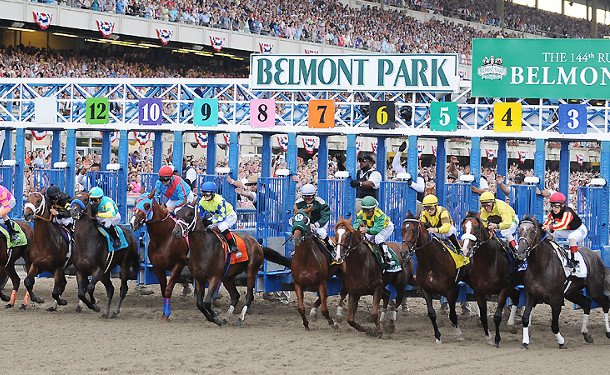
Horse players and owners in horse racing partnerships love the “Big Day” of stakes laden cards. Racetracks hold these events as a way to boost handle and attendance as well as generate interest in the media. The recent Belmont Stakes Festival of Racing is a prime example of a racetrack embracing the mentality and making it even bigger. The festival featured 19 stakes races held Thursday through Sunday with purses worth around $10 million. On Belmont Stakes day itself, 10 of the 19 stakes races were held worth a staggering $7.5 million making it the second biggest day in terms of purses distrusted second only to Breeders Cup Saturday.
So, why the huge festival? NYRA is in a challenging spot in that The Belmont Stakes Day’s success hinges on what takes place at Pimlico three weeks prior. To illustrate this, consider Belmont Stakes Day of 2008; I would have used 2012 but if you recall the horse “I’ll Have Another” was a late scratch. Total attendance was 94,476 with all source handle of nearly $100 million wagered on the card that would see Triple Crown hopeful Big Brown go down in defeat. By comparison, in 2013 there was no Triple Crown and attendance dropped to 47,562 with handle down to $88 million.
In an attempt to allow the day to stand on its own without a Triple Crown attempt, NYRA moved several big races to create this must see event, and it worked… somewhat. The 2014 Belmont Stakes Day set a record for all source handle with over $150 million with attendance of 120,139. In 2015, all source handle was over $135 million with attendance capped at 90,000. NYRA managed to capture lightening in a bottle with two Triple Crown attempts in succession since the implementation that certainly helped these days. With no Triple Crown attempt on the line, the 2016 figures provided a more realistic picture.
All source handle totaled $99 million up over $10 million or 12% from 2013 which was the last year a Triple Crown was not on the line. Most would think that the increase was a positive but one would have to consider that the purses offered in 2013 for six stakes races totaled $2,950,000 compared to $7,500,000 for ten stakes in 2016. If you view the stakes through purse yield per handle dollar, 2013 was $24.75 ($73,005,935/$2,950,000) compared to $12.21 ($91,605,269/$7,500,000) for 2016. In case you were wondering how they fared with a Triple Crown on the line, the figures were $18.19 and $16.75 for 2014 and 2015, respectively.
The second part of the purse structuring is how the purses themselves are funded. Most tracks around the country that are not associated with a casino fund their purses through the wagering handle. At NYRA the purses are funded through the wagering handle and are fortunate enough to have VLT subsidies. The three components of purse funding are derived from a percentage of on and off track handle as well as the VLTs and nomination fees (usually at 1.5% of the purse, unless it is an invitational and then there is none). Purses from on track handle are funded at a rate of 6% and off track are generated at a host fee of 8% (split 50/50 with horsemen) on average since the agreements with different outlets will vary. In 2013 and 2016 on track handle for the stakes races were approximately $9 million and $10 million funding the purses $540,000 and $600,000. Off track in 2013 and 2016 were $64 million and $81 million funding the purses $2.56 million and $3.3 million.
VLT funding excluded, purse contributions from handle totaled $2.96 million in 2013 and $3.9 million in 2016. When you compare these figures to the purses being offered, 2016 was in a serious overpayment situation of several million dollars. While not as severe as 2013, both Triple Crown years of 2014 and 2015 were also in an overpayment situation.
I believe the Big Day is here to stay, but does need to be revised. It is reasonable to expect they will attract the same quality fields with lower purses. During the first year total stakes purses were $7.7 million and have decreased subsequently. I would expect this number to continue to trend downward. Far too often racetracks love the idea of the $1 million race simply because it sounds good, even if it doesn’t make fiscal sense. An overpayment situation means less money for the overnights going forward and could further compound the field size problem. Sometimes bigger isn’t always better, but at the same time there are other measures of success that cannot be whittled down to a number. As a betting man, I would gladly wager on the prospect that new fans were created from this event that could prove to be repeat visitors in the future. The Big Day isn’t perfect by any stretch, but it is almost there. The old saying goes “Almost only counts in horseshoes and hand grenades”. Fortunately for us, we have plenty of the former.
{{cta(‘7f90c40d-053f-4143-b319-a06be60edf5d’)}}
